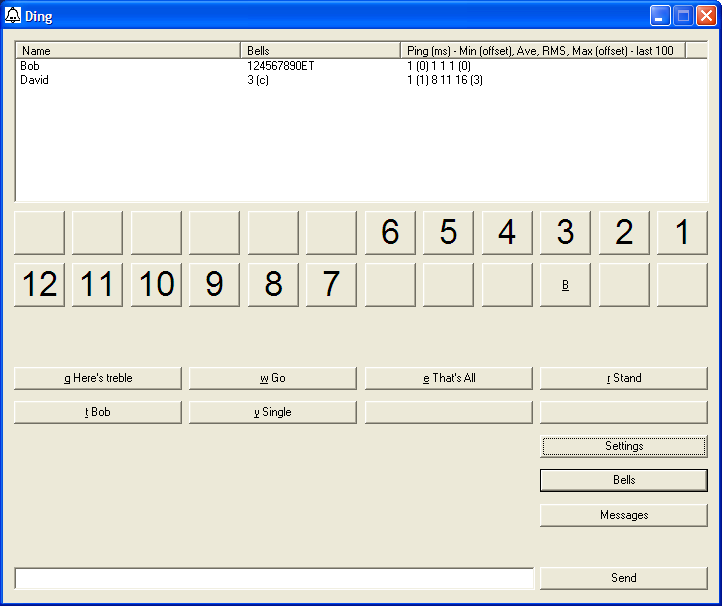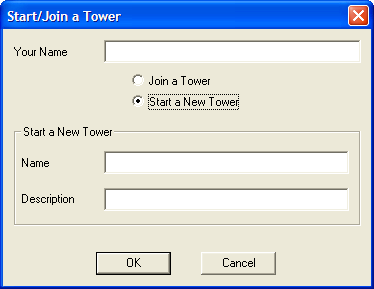

Ding

Using Ding Standard
Starting or Joining a Tower
Once you have installed Ding, the first thing you have to do is either start a new tower, or join a tower which someone else has started.
Starting a New Tower
Run Ding. The Start/Join a Tower box should appear. Select the option to start a tower. You should now see this:

Enter your name in the box at the top, and enter the name of your tower and a short description (e.g. "David's Private Tower" or "Please join me for some ringing"). Then click OK and the tower is created.
Joining a Tower
Run Ding. The Start/Join a Tower box should appear. Select the option to join a tower. You should now see this:

Enter your name in the box at the top, and select the tower to join. Click OK and you should be in the tower.
Getting started
Once you have created/joined a tower, you should see the main page.

The first step is to allocate bells to ringers. Click the "Bells" button and a popup appears. In this popup, you can select who is ringing which bell. You do not have to allocate all bells, but you must allocate them sequentially from 1. Dropdown each box and select a ringer. As you are the only person in the tower, you will be the only option, so give yourself Bells 1 to 6. Click OK, and now the bell buttons appear.

Now click the button above "1" and you will hear the treble ring, and the number move to the top button. Then click the button below the "1" and the reverse will happen as it rings again. You are now ringing. If someone else joins the room, they can hear you, and you can allocate them bells so that they can ring some while you ring others.
Each button you can click also has a letter on it. Press that key on the keyboard to ring the bell. Note that when you do, the letter to bring it back again is different. The keyboard layout also changes depending on the number of bells - with up to 4 bells, it's laid out to have one or two bells per hand, whereas with 5 or more, it's laid out to be rung more like a piano. Some people find it easier to ring using the mouse, but most use the keyboard.
Settings
Next click the settings button. This brings up another popup, with three settings you can change.
The top box controls how the mouse works. By default, as above, you click the top button to move the bell to the top position, then the bottom button to move it back. However, by changing the first box to "Click either button to move number", you can click either button to move the bell to the opposite position - so if you click the same button repeatedly, the bell will move up and down with each click.
The next box controls how the keyboard works. By default, as above, there is a different key to ring the handstroke and the backstroke. However, if you change this setting to "One key per bell", it then uses the same key for both strokes. Most ringers find that they caan get going more quickly with one key per bell, but in the long term, having two keys per bell tends to give more of a feel for handstrokes and backstrokes, and avoids "double-ringing" a bell.
The third box determines which bells to use for a given number of bells being rung. The bell audio is taken from a 12 bell tower with a flat 6th (6b), Therefore by selecting the number of bells and a heavy, medium or light ring, you can change which bells are used as follows:
| Bells | Light | Medium | Heavy |
| 4 | 2-3-4-5 | 5-6-7-8 | 9-10-11-12 |
| 5 | 1-2-3-4-5 | 4-5-6-7-8 | 8-9-10-11-12 |
| 6 | 3-4-5-6-7-8 | 4-5-6b-7-8-9 | 7-8-9-10-11-12 |
| 7 | 3-4-5-6b-7-8-9 | 6-7-8-9-10-11-12 | |
| 8 | 2-3-4-5-6b-7-8-9 | 5-6-7-8-9-10-11-12 | |
| 9 | 1-2-3-4-5-6b-7-8-9 | 4-5-6-7-8-9-10-11-12 | |
| 10 | 3-4-5-6-7-8-9-10-11-12 | ||
| 11 | 2-3-4-5-6-7-8-9-10-11-12 | ||
| 12 | 1-2-3-4-5-6-7-8-9-10-11-12 | ||
And the fourth option allows you to replace the numbers on the bells with X's. Some ringers found having the numbers there was confusing.
Chatting
The final function we'll cover at this time is the Chat function. Type a message in the box at the bottom of the page and then click Send, and the message will appear in the chat space for everybody in the tower. Note that if the focus is on the chat text entry, then you can't use the keyboard to ring bells!
The rest of the functionality will be covered in further pages, starting with how to use Bob - the automated ringer which you can use to practice solo, or to allow a band to ring more bells than they have ringers available to ring.